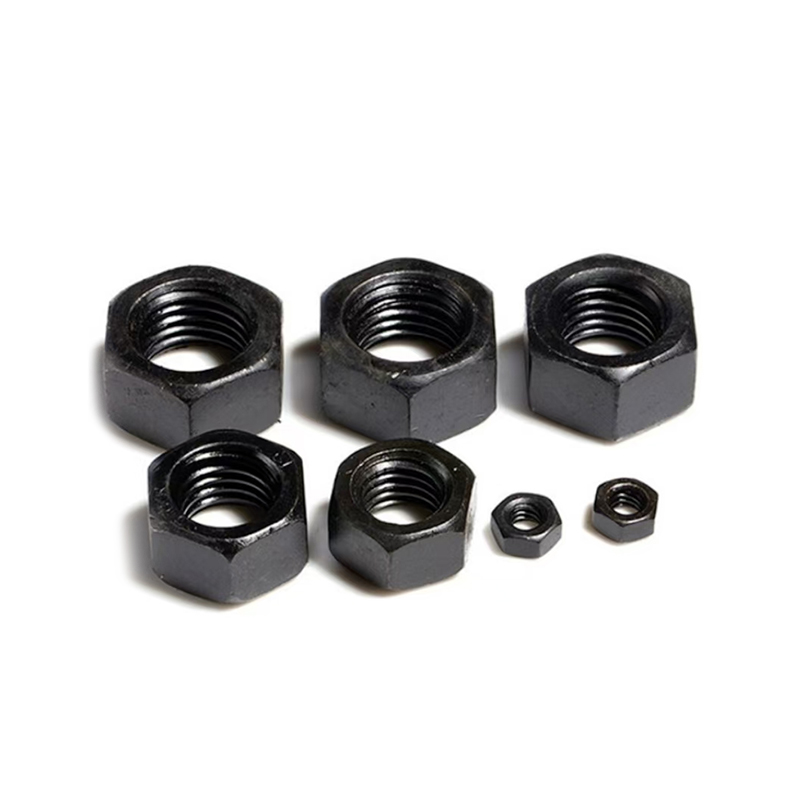The grade of carbon steel used in the production of hexagon nuts significantly influences their performance in both high-stress and corrosive environments.
1. Mechanical Properties (Tensile Strength and Hardness)
Higher-grade carbon steel (e.g., AISI 1045, AISI 1060) has better tensile strength and hardness compared to lower grades (e.g., AISI 1018). This means higher-grade nuts are capable of withstanding higher load-bearing forces without deformation or failure, making them suitable for high-stress environments.
Tensile strength is particularly important in applications where the nuts must secure heavy machinery, automotive parts, or structural components that experience dynamic or static loads. In high-stress environments, nuts with higher-grade steel provide better resistance to stretching or shearing forces.
Hardness contributes to the carbon steel hexagon nut's resistance to wear and deformation under high-pressure conditions, ensuring that the nuts remain securely fastened without compromising their shape or integrity.
2. Fatigue Resistance
Fatigue resistance refers to the ability of the material to withstand repeated loading cycles without failure. Higher-grade carbon steel generally offers better fatigue resistance, which is crucial for applications where hexagon nuts are subjected to repetitive stresses or vibrations (e.g., in engines, conveyors, or large industrial machines).
Lower-grade carbon steels tend to be more prone to fatigue failure under cyclic loading because they are less able to resist crack initiation and propagation over time.
3. Corrosion Resistance
While carbon steel is generally susceptible to corrosion, the grade can influence its ability to withstand corrosive environments.
Low-carbon steels (e.g., AISI 1018) are more prone to rusting, especially when exposed to moisture, chemicals, or harsh weather conditions. In these environments, these nuts may require additional coating (e.g., zinc plating, galvanization, or powder coating) to protect against corrosion.
High-carbon steels (e.g., AISI 1045 or 1060) can be more resistant to wear but still require protective coatings or heat treatment to improve their resistance to corrosion, as the carbon content can make them more reactive to environmental factors.
Heat-treated or alloyed carbon steels (such as 4140 steel, which contains chromium and molybdenum) can provide improved corrosion resistance in certain industrial environments, though they still require coatings in extremely corrosive environments (e.g., marine or chemical processing environments).
4. Impact Resistance
Higher-grade carbon steels generally have better impact resistance, meaning they can absorb shocks or sudden forces without fracturing. In applications where hexagon nuts are exposed to shock loads (e.g., machinery prone to vibrations or impacts), higher-grade steel ensures the nuts maintain their integrity and do not fail under high-impact conditions.
Lower-grade steels may have a brittle fracture tendency when exposed to sudden impacts or low temperatures, making them unsuitable for certain high-stress applications.

5. Heat Resistance
Higher-grade carbon steels usually offer better heat resistance, which is critical in high-temperature environments such as engines, industrial furnaces, or aerospace applications. In these environments, hexagon nuts are exposed to elevated temperatures that can soften and weaken lower-grade materials.
Heat-treated high-carbon steels can maintain their structural integrity at higher temperatures, preventing premature wear or failure under heat-induced stress. However, the presence of alloying elements (like chromium or molybdenum) in high-strength carbon steels may improve both heat resistance and corrosion resistance simultaneously.
6. Ductility and Malleability
Lower-grade carbon steel tends to be more ductile and malleable, allowing it to deform slightly under load. This property can be advantageous in applications where slight deformation helps the nut absorb shock or vibration without cracking.
However, in high-stress environments where exact tolerances and strength are required (such as in precision machinery or structural applications), higher-grade carbon steel is often preferred for its better strength and less deformation under load.
7. Cost vs. Performance
Higher-grade carbon steels typically cost more due to the added alloying elements or additional heat treatments. Therefore, the choice of grade should be based on the specific needs of the application, balancing cost-efficiency with the required performance characteristics. For example, in non-critical applications, a lower-grade carbon steel may suffice, but in high-stress or corrosive environments, the investment in higher-grade steel ensures greater reliability and longevity.

 English
English 中文简体
中文简体 Español
Español русский
русский عربى
عربى








